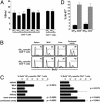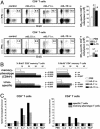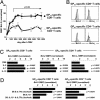IL-7 regulates basal homeostatic proliferation of antiviral CD4+T cell memory
- PMID: 15197277
- PMCID: PMC438981
- DOI: 10.1073/pnas.0400640101
IL-7 regulates basal homeostatic proliferation of antiviral CD4+T cell memory
Abstract
Heightened protection from infectious disease as conferred by vaccination or pathogen exposure relies on the effective generation and preservation of specific immunological memory. T cells are irreducibly required for the control of most viral infections, and maintenance of CD8(+)T cell memory is regulated by at least two cytokines, IL-7 and IL-15, which support survival (IL-7, IL-15) and basal homeostatic proliferation (IL-15) of specific CD8(+) memory T cells (T(M)). In contrast, the factors governing the homeostasis of pathogen-specific CD4(+)T(M) remain at present unknown. Here, we used a physiologic in vivo model system for viral infection to delineate homeostatic features and mechanisms of antiviral CD4(+)T(M) preservation in direct juxtaposition to CD8(+)T cell memory. Basal homeostatic proliferation is comparable between specific CD4(+) and CD8(+)T(M) and independent of immunodominant determinants and functional avidities but regulated in a tissue-specific fashion. IL-7, identified as the dominant cytokine, and IL-15, an accessory cytokine, regulate basal homeostatic proliferation and survival of antiviral CD4(+)T(M). Interestingly, a role for these cytokines in regulation of CD4(+)T cell memory is not readily discernible in the generic "memory-phenotype" population, apparently a consequence of its heterogeneous composition. We also describe a prominent, nonredundant role for IL-7 in supporting basal homeostatic proliferation of CD8(+)T(M). We propose that homeostatic control of antiviral CD4(+) and CD8(+) T cell memory is fundamentally similar and characterized by quantitative, rather than qualitative, differences.
Figures





Similar articles
-
Interleukin (IL)-15 and IL-7 jointly regulate homeostatic proliferation of memory phenotype CD8+ cells but are not required for memory phenotype CD4+ cells.J Exp Med. 2002 Jun 17;195(12):1523-32. doi: 10.1084/jem.20020066. J Exp Med. 2002. PMID: 12070280 Free PMC article.
-
IL-15-dependent upregulation of GITR on CD8 memory phenotype T cells in the bone marrow relative to spleen and lymph node suggests the bone marrow as a site of superior bioavailability of IL-15.J Immunol. 2012 Jun 15;188(12):5915-23. doi: 10.4049/jimmunol.1103270. Epub 2012 May 11. J Immunol. 2012. PMID: 22581858
-
IL-7 administration alters the CD4:CD8 ratio, increases T cell numbers, and increases T cell function in the absence of activation.J Immunol. 2001 Mar 1;166(5):3019-27. doi: 10.4049/jimmunol.166.5.3019. J Immunol. 2001. PMID: 11207251
-
Epigenetic Maintenance of Acquired Gene Expression Programs during Memory CD8 T Cell Homeostasis.Front Immunol. 2018 Jan 18;9:6. doi: 10.3389/fimmu.2018.00006. eCollection 2018. Front Immunol. 2018. PMID: 29403491 Free PMC article. Review.
-
Homeostasis of memory T cells.Immunol Rev. 2006 Jun;211:154-63. doi: 10.1111/j.0105-2896.2006.00401.x. Immunol Rev. 2006. PMID: 16824125 Review.
Cited by
-
Bim mediates apoptosis of CD127(lo) effector T cells and limits T cell memory.Eur J Immunol. 2006 Jul;36(7):1694-706. doi: 10.1002/eji.200635897. Eur J Immunol. 2006. PMID: 16761315 Free PMC article.
-
A conserved CXXC motif in CD3epsilon is critical for T cell development and TCR signaling.PLoS Biol. 2009 Dec;7(12):e1000253. doi: 10.1371/journal.pbio.1000253. Epub 2009 Dec 1. PLoS Biol. 2009. PMID: 19956738 Free PMC article.
-
Memory phenotype CD4 T cells undergoing rapid, nonburst-like, cytokine-driven proliferation can be distinguished from antigen-experienced memory cells.PLoS Biol. 2011 Oct;9(10):e1001171. doi: 10.1371/journal.pbio.1001171. Epub 2011 Oct 11. PLoS Biol. 2011. PMID: 22022231 Free PMC article.
-
Memory CD4 T cells in influenza.Curr Top Microbiol Immunol. 2015;386:399-421. doi: 10.1007/82_2014_401. Curr Top Microbiol Immunol. 2015. PMID: 25005927 Free PMC article. Review.
-
Induction and function of virus-specific CD4+ T cell responses.Virology. 2011 Mar 15;411(2):216-28. doi: 10.1016/j.virol.2010.12.015. Epub 2011 Jan 14. Virology. 2011. PMID: 21236461 Free PMC article. Review.
References
-
- Sprent, J. & Surh, C. D. (2002) Annu. Rev. Immunol. 20, 551-579. - PubMed
-
- Ahmed, R. & Gray, D. (1996) Science 272, 54-60. - PubMed
-
- Zinkernagel, R. M. (2002) Curr. Opin. Immunol. 14, 523-536. - PubMed
-
- Whitton, J. L. & Oldstone, M. B. (2001) in Field's Virology, eds. Fields, B., Howley, P. M., Griffin, D. E., Lamb, R. A., Martin, M. A., Roizman, B., Straus, S. E. & Knipe, D. (Lippincott, Philadelphia), pp. 285-320.
Publication types
MeSH terms
Substances
Grants and funding
- CA38355/CA/NCI NIH HHS/United States
- AI21487/AI/NIAID NIH HHS/United States
- 00080/PHS HHS/United States
- DK58541/DK/NIDDK NIH HHS/United States
- AI46710/AI/NIAID NIH HHS/United States
- P01 AG001743/AG/NIA NIH HHS/United States
- AI45927/AI/NIAID NIH HHS/United States
- R01 AI045927/AI/NIAID NIH HHS/United States
- R01 AI046710/AI/NIAID NIH HHS/United States
- AI09484/AI/NIAID NIH HHS/United States
- R37 CA038355/CA/NCI NIH HHS/United States
- R01 DK058541/DK/NIDDK NIH HHS/United States
- R01 AI009484/AI/NIAID NIH HHS/United States
- AG01743/AG/NIA NIH HHS/United States
LinkOut - more resources
Full Text Sources
Other Literature Sources
Molecular Biology Databases
Research Materials

